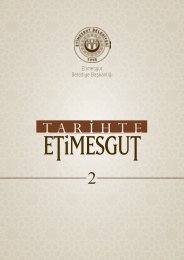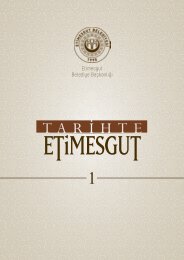BİLDİRİ ÖZETLERİ / ABSTRACT BOOK
Create successful ePaper yourself
Turn your PDF publications into a flip-book with our unique Google optimized e-Paper software.
Uluslararası Tarihte Etimesgut Sempozyumu (UTES)<br />
ETİMESGUT AS THE LIVING PLACES FROM ATATÜRK'S SAMPLE<br />
<strong>ABSTRACT</strong><br />
VİLLAGE TO THE MUNİCİPALİTY OF THE 1990S<br />
The nonresidential of immigrants who came to Turkey with the exchange, has been a<br />
subject that requires ongoing solutions starting from the Ottoman period, to the early years<br />
of the Republic. "Sample Village Project" has put an end to the solution proposal searches.<br />
The project was an opportunity to pass on to the modern villages and the facts about how the<br />
daily life of the village people should be which laid out in the "Village Law" adopted in 1924.<br />
This project, which is the proposal of Atatürk and which he is interested in personally, is of<br />
great importance both in terms of forming an example of other villages and of the placement<br />
of immigrants when the situation of the country is taken into consideration after the War of<br />
Independence. Within this scope, 69 sample villages were built in our country.<br />
The first application of the "Sample Village Project" is Atatürk's "Ahimesut Sample Village".<br />
Atatürk applied items in the Village Law items to Ahimesut one by one. The houses were built<br />
within a certain plan, the first inhabitants of the village were placed in these houses, immigrants<br />
from Bulgaria. The social facilities of the village were constructed quickly and the villages were<br />
given vineyards and landscapes, allowing modern methods to be used.<br />
In Ahimesut Village, a life began in terms of these conditions But how did this life continue?<br />
How were the houses and social facilities that built with the interest of Atatürk, used? What<br />
new spaces have been added to these places until the sample village became to<br />
neighborhood? How did life went in these areas in Ahimesut Sample Village until it becomes<br />
to municipality? What happened in these spaces and what happened to the spaces? These<br />
questions constitute the starting point of this work.<br />
In order to answer these questions, oral history method which is a qualitative data collection<br />
method was used. A semi-structured in-depth interview was conducted with people already living<br />
in the area of Example Village before becoming Station District In 1968. In other words, Interview<br />
had been done with immigrant grandchildren who lived in Etimesgut for at least 50 years, with<br />
migrants and shopkeepers from neighboring villages. Snowball sampling method is used to reach<br />
these people. A semi-structured in-depth interview was conducted with ten people for an hour,<br />
and a second in-depth interview was conducted with three people for another hour.<br />
The memories of those interviewed about these constructions, which are considered as<br />
living spaces, and their thoughts about the memories and the present state of the structures<br />
have been revealed in the study.<br />
Keywords: Ahimesut, Etimesgut, Sample Village, Immigrants, Bulgarian Immigrants, Etimesgut's<br />
Constructions<br />
77






